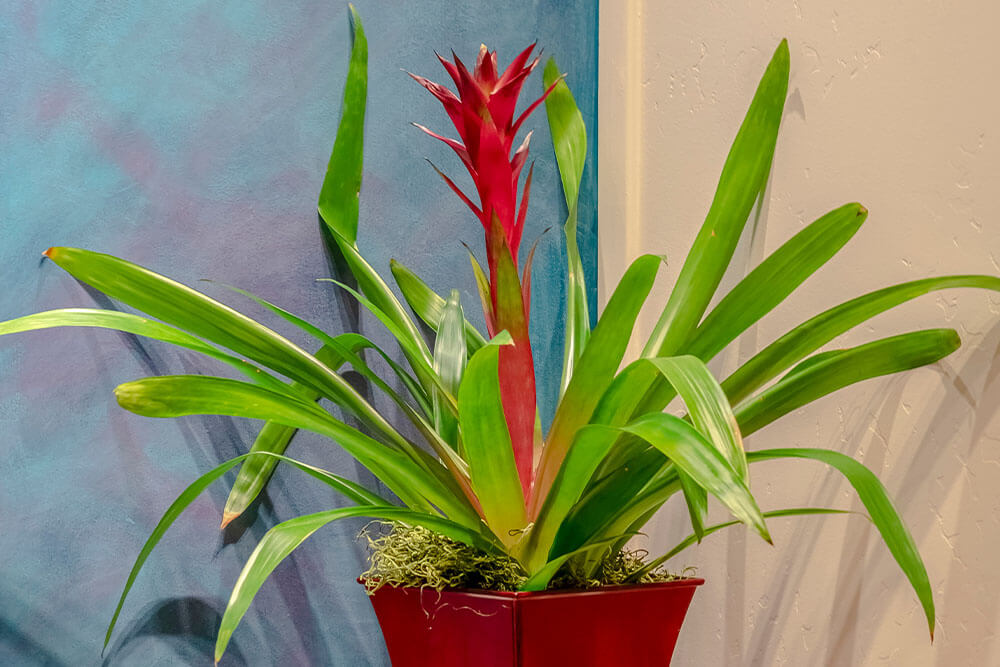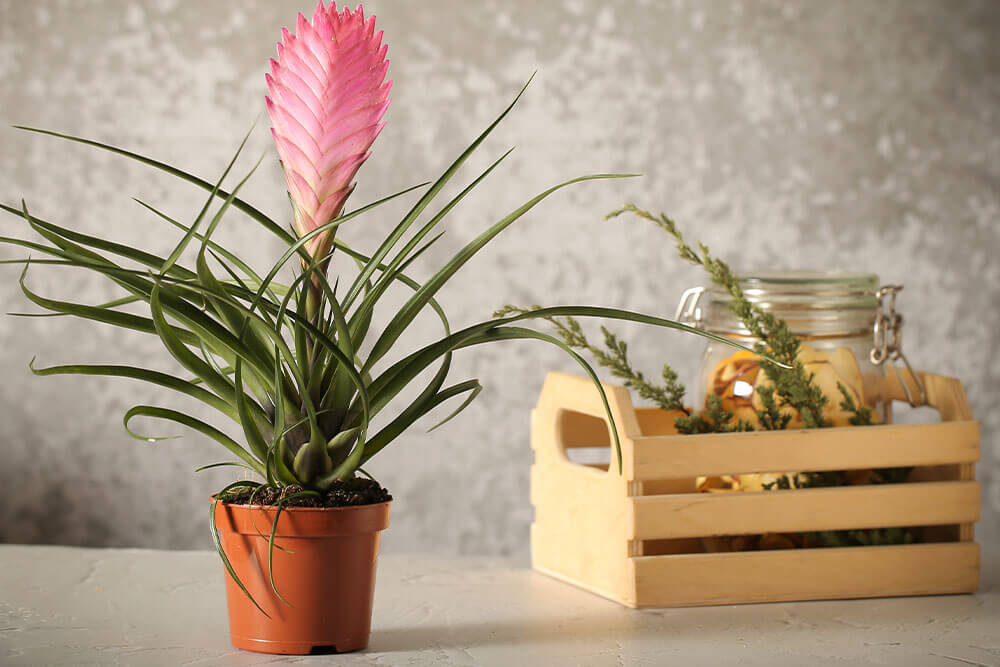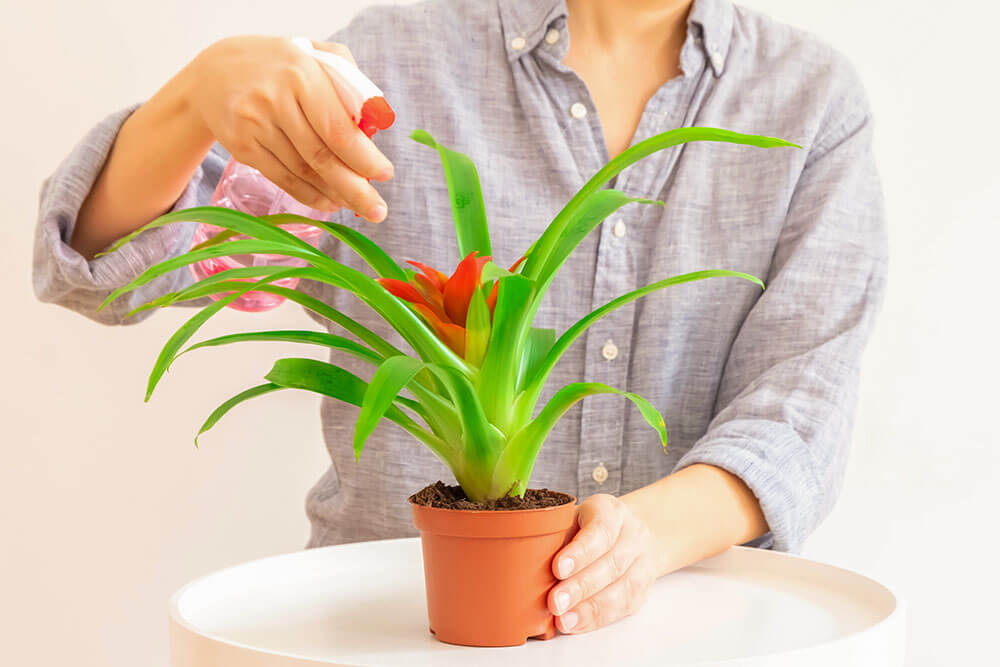In the gardener’s dictionary, if you look up the word diversity, you’ll find Bromeliads there. There are nearly 3,000 species of this plant. Each one may have unique care specifications. Thankfully, there are underlying principles for bromeliads care.
Following tips and information about your bromeliad, you will have a year-round addition to your indoor garden.
The Bromeliad Native Habitat
Bromeliad is a neotropical plant with its home in South America, specifically Brazil. You can find them in Argentina, the Caribbean, Chile, and Central America. If you’re growing an outdoor bromeliad, you need to live below Virgina for warmth. It seems Bromeliads are not afraid of heights. They live as hardily at sea level as they do at 14,000 feet.
There are three specific areas in which you can find bromeliad growing. The first environment is on the ground, liking bright light with periods of shade. Second are bromeliads growing on rocks.
Their roots penetrate the cracks in outcrops. This type of bromeliad becomes a unique addition to your indoor rock garden. The third species grows on other plants, including cactus, shrubs, and trees. The name “air plants” suits this bromeliad just fine, and it gathers nutritional necessity and water directly from the atmosphere.
Flower Power: It is a sad truth that the vast majority of bromeliads flower only once during their lifespan. The flowers (bracts) burst open in red, pink, purple, yellow, orange, or blue inflorescence. impressive against the green backdrop. While bromeliads rarely grow higher than 3 feet indoors, the flowers pop up above the main plant, so you cannot miss them. The lifespan of bromeliad flowers is 2-4 months, after which it dies off, and the plant grows baby “pups” for the next generation.
Keynotes for Indoor Bromeliads Care
The steps for keeping your bromeliad healthy and happy are pretty simple. Make sure to keep them out of direct sunlight, and don’t crowd them. They require airflow (which also deters pests).
If your house is dry, mist your plants regularly or place a small humidifier nearby. Check the soil periodically to make sure it’s not soggy. The plant requires excellent drainage.
You can take your indoor bromeliad outdoors on warm days, but avoid doing so when the temperature looks to drop below 45F. Note that a vacation outdoors means possible pests coming into your home. Check your plant!
Finally, while it might be tempting to do so, don’t over-fertilize. A little goes a long way.
A Famous Family Member: The distinguished pineapple is a bromeliad! A tasty surprise, but other plants in the family don’t sound yummy at all. They include aloe, yucca, and Spanish moss.

Standards for Growing Bromeliads
The basic daily needs for indoor bromeliads are pretty forthright. Focus on these five things:
- Fertilization: These plants usually don’t require much fertilizer at all. While you may want to encourage faster growth in your plant using soil supplements, take care. Bromeliads grow slowly. Too much fertilization only produces a plant with dulled colors and leggy leaves.
- Humidity: Your bromeliad craves 60% humidity, which can be hard to maintain in your average home. To help improve the humidity for your plan, take a tray, and fill it with pretty stones. Pour in water so it’s just under the top surface of the stones. Place your bromeliad pot right on top or nearby. Make sure the bottom of the pot (where there are drain holes) is never directly in the water.
- Light: Each variety of Bromeliad had different lighting needs ranging from indirect to constant shade. In your home, find a place with indirect sunlight. If you live where it gets cold in winter, offer your bromeliad a place in the sun at a south-facing window.
- Pots and Soil: Look for unglazed pots for your plant with several drain holes. Avoid metal containers at all costs. Metal can devastate your plant. Make sure you have some type of protective saucer under the plant to catch excess water. For potting mix, a blend designed for bromeliads is best.
- While bromides are drought tolerant, they do not appreciate over-watering. The key to success is fully saturating your plant, letting it drain, and then waiting until the soil is dry down to 2 inches.
In ancient times, the Aztecs and Mayans perceived bromeliads as a diving gift. If you look at the flower, you can almost imagine why. It points straight upward like an antenna tuned to the Universe. The plant was a spiritual protector, warding off negative intent. They used nearly every plant part to make fiber, shelters, as food, and in rituals.
In art and literature, the bromeliad represents desire, temptation, love, and originality. Because they abide in harsh environments, there’s a natural association with adaptability, overcoming, and resilience.
Dreaming of bromeliad is a positive omen of renewal and positive changes. If the flower is red, the message has to do with your passion. Yellow flowers bring joy, and pink flowers mean you are graceful even in difficult situations.
Gifting a bromeliad to a newly married couple symbolizes good luck and good wishes.
Buyers Guide to Bromeliads
There are hundreds of bromeliads in the marketplace. Below are some consumer favorites. But before you buy, there are tricks to finding a healthy plant. Soggy soil is a no-no. The plant may already have root rot.
Next, look at the leaves. Are they bright green and perky (a good sign)? Are there any yellowing or brown spots? Do fronds droop? These are bad signs.
While you examine the plant, also be on the lookout for telltale signs of pets, like the web from a spider gnat.
Finally, look for a plant that’s just starting to show its colors. It will live longer than one in full-color maturity.
- Air Plants: An umbrella name for the largest group of epiphytic bromeliads. The leaves have scales, appearing silver-gray. When they blossom, the leaves may begin to blush. Flower stalk colors include red, orange, blue, and white. These plants thrive in bathrooms and over kitchen sinks.
- Earth Stars: A low-lying plant that grows in a shape similar to that of a starfish. You can’t beat these glorious leaves, which may manifest in brown, bronze, pink, silver, or white (oh, yes, green too). Make sure they receive organic soil in a dish garden.
- Fingernail Plant: You don’t really need flowers when you have spectacular foliage. The leaves grow in bronze, green, pink, purple, orange, yellow and white.
- Neoregelia: The leaves of this bromeliad are nearly as lovely as its blushing flower. Although the blossoms are smaller than some, the fronds look marbled with orange, purple, red, or pink more than compensate.
- Pink: As the name implies, this plant produces a hot pink quill crowned in blue-purple flowers, suited for a boa! The dark leaves are the perfect backdrop.
- Urn: A sad nickname for such a pretty plant. It’s because the salmon pink flower grows in the shape of an ear. Very interesting leaves here: silvery green.
- Vriesea: The flower looks ready for battle with a flaming sword. The red sets off variegated foliage. It’s a truly stunning plant.
Bromeliad Trivia: Pineapple stems make great meat tenderizer (and also fresh fruit juice). The Caroa bromeliad grows as a source of fiber. And Spanish moss has a core once used for stuffing upholstery.
Bromeliad Watering Techniques
Inevitably one question a novice about bromeliad poses is, do you water this thing from the top or bottom? The way in which bromeliads grow creates a “cup” in the center. Water them from the top, filling the cup until it runs over. This is like having a backup generator. The only caution here is checking that water regularly. If it gets old, flush it out.
Some indigenous cultures see bromeliads as sacred. Their flowers are the tears of the Gods. By extension, the medicinal purposes for the leaves add to the idea God gifted bromeliad to humans as a helpmate.
Spanish Moss in particular, has a myth about its origins. During the time of wayfaring, Gorez oz (an explorer) purchased a young, native girl. She was terrified of him, running as quickly as she could at the first chance. He followed to find her climbing into a tree and then diving into the water below. He attempted to follow, but the plant entangled his beard, and he met his death there. His beard continues growing as the Spanish Moss. This story is why this plant is also called “graybeard.”
Potting and Repotting Bromeliads
In shopping for soil, you want an acidic potting mix that drains well while still holding moisture. A blend of humus, perlite, and orchid mix should do the trick. Find a clay pot with several drainage holes. Keep the size of your plant’s root system in mind. When pots are too large, it encourages wetness.
Bromeliads are slow growers, so the only time you may have to repot it is when you get home from the garden center.
Baby Bromeliads: After flowering, most species start sending out offsets called “pups.” When the offset is about ⅓ the size of its mother, you can separate it and start growing the second generation. Until they’re well-established, keep the pups in a shadier location. Let those new roots grow!
Bromeliads Pruning and Maintenance

When dead leaves appear, gently pick them off. They serve no purpose. When the flower dies back, you want to prune it. Now your plant can redirect energy to developing pups.
Once the mother plant dies back, you can shape it and leave the pups to grow to size.
There is a purpose to pruning besides visual appeal. It will help your bromeliads grow and promote their health. Pruning can remove diseased parts of your plant or unwittingly some critters who roost there. By the way, your plant will sprout in the direction you prune it.
New World Bromeliads: In 1493, Columbus discovered a pineapple thriving in the West Indies. He gathered it up and brought it back to Spain. It wasn’t long before pineapple became popular. Cultivation to this day continues in Europe.
Blooming and Resting Period for Bromeliad
When the months grow darker, slow down bromeliad watering. Space it out to between 6-8 weeks. The center cup of the plant should be no more than ¼ full. Stop fertilizing altogether.
Technically speaking, the plant is dying after flowering. It takes a year. But if you treat it kindly, you can stretch that for five years, just no flowers. Giving your bromeliad plant, TLC encourages the growth of pups, too.
If you are always on the run and don’t have time for fussy plants, you will love the bromeliad. Give them light, humidity, and good soil, and your plant nearly grows itself. By the way, Bromeliads are safe for pets.
What’s Bugging You? Bromeliads Common Pests & Diseases
Inside your home, diseases aren’t prevalent. Root rot is common, but you can remedy that by sticking to a continuity in your water routine. You can also check the soil mix.
Mites, scale, and mealybugs might show up. You could have brought them from the greenhouse, maybe one hopped on a piece of clothing and made themselves welcome, or there might be some critters lingering in your other plants. When you water, be on the lookout for signs of trouble. Insecticidal soap, horticultural oil, or neem oil are all effective.
Scale looks like a little brown oval on your leaf. You can swab them off with rubbing alcohol. When you rinse afterward, it removes eggs. Mealybugs are stubborn. They look oval and kind of fuzzy. Clean them off with rubbing alcohol as with scale.
By the way, mosquitos love to breed in bromeliad’s cup. So diligently refresh it periodically. Aphids might nibble at the roots and make leaves slip. To be on the safe side, take them outside and spray them with a garden hose. The water knocks them (and some other bugs) off.
Rust Disease and Leaf Spot
If you notice red-brown lumps on the backside of your foliage, that’s rust. Most often, it means you’re overwatering your plant. Trim out any affected leaves and toss them. Let the plant dry out and make sure it gets proper air circulation.
Leaf spot is a little different. It appears as a sunken brown spot on the leaves. This happens from overhead watering.
Healing Plant; Healthy Home: Several studies indicate bromeliad flowers improve air quality. Toxins go into the plant, oxygen comes out! More oxygen inspires better sleep and supports your immune system. Bromeliads may only help in the region it “lives,” but then again, you could get one for every room of the house!

Troubleshooting Common Bromeliad Problems
There are several common problems discussed among owners of bromeliads.
- Browning Flower: It may simply be the result of the flower’s inevitable death. The flowers only last a few months.
- Browning at the base: A strong indicator of root rot. Remove the plant, clean dead and mushy material off it, and then put it into a fresh batch of planting mix. Be careful about watering too much.
- Brown Leaf Tips: The leaves are reacting to too much sun. They’re “burnt,” so to speak. Move the plant to a location with indirect lighting.
- Not Blooming: You get colder colors and faster blossoming from adequate light. A little fertilizer applied during the growing season can improve your results.
- No variegation: There’s not enough light. When you place them in an area where they receive indirect sunlight, you’ll find the colors picking up.
- Smelly center: If you get a whiff of a rotting smell, it may have heart rot. The center of the plant looks soggy and brown. When you touch the leaves, they fall off easily. You can treat this with fungicide, but meanwhile, get healthy plants away and into their own space.
- Soft, white substance: This is salt buildup. Rinse it off with distilled water. Wipe the leaves afterward and go to using filtered water.
- Withering: Your plant needs more humidity. Leave it in the bathroom for a while, or put a humidifier in the area.
- Yellow Leaves: Pale foliage can mean your plant isn’t getting proper nutrients. If the leaves are long and thin, your plant needs more light (8-10 hours daily).
Enter Center Stage: The Tree Frog: Mexican legend says when the fog in the cloud forest parts allowing the sunshine to kiss the soil, it announces a bromeliad tree frog’s birth. Alternatively, the light is the golden shine of the tree frog itself.
[wp-faq-schema title=”Frequently Asked Questions About Indoor Bromeliads” accordion=1]Summary
The life of a bromeliad is short, but that doesn’t lessen our appreciation of them. They are an ideal indoor plant. Yes, the flowers are famous, but the foliage on these plants can be just (if not more) exciting. When the blossom finally arrives, it’s like welcoming a baby…okay, maybe not that celebratory. But when you know the plant only visits for a few months, you pay more attention. It’s exciting.


